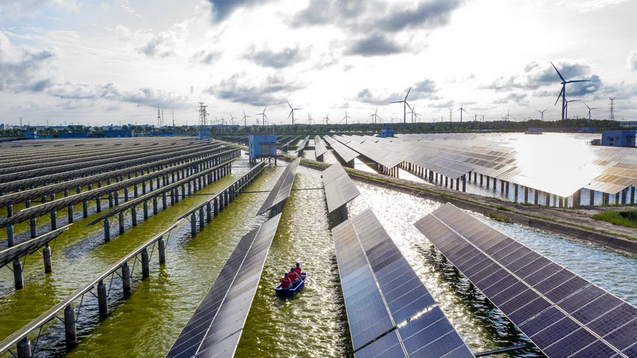When it comes to facing up to the reality of combatting climate change, the Coalition has utterly failed

|
|
‘Scott Morrison did specifically link electrical vehicles
to weekend destruction.’
Photograph: James Ross/AAP
|
On Tuesday, Chris Bowen asked Scott Morrison about the IPCC report and, if he was in favour of “more technology” to combat climate change, “why did the prime minister claim that electric vehicles would end the weekend?”
Morrison fobbed the question off to Angus Taylor but not before replying “the claim made by the questioner is false”.
Well now.
It took those listening less time than it took Taylor to get to the dispatch box to produce evidence that the claim made by the questioner was true.
Morrison claims Australia will make our Paris target cuts of 26% 'in a canter' despite all evidence to the contraryIn April 2019, Morrison told reporters that, “Bill Shorten wants to end the weekend when it comes to his policy on electric vehicles, where you’ve got Australians who love being out there in their four-wheel-drives.”
Now maybe he could wriggle out by saying he didn’t say electrical vehicles would end the weekend but Shorten’s policy on electrical vehicles would – this was Morrison’s own explanation made after question time.
But are we so base that we should hold the prime minister of Australia to such a pathetic standard?
Because Morrison did specifically link electrical vehicles to weekend destruction.

|
|
‘No place to hide’: pressure on Australia to end support for new
fossil fuel projects after IPCC report.
Read more
|
" That’s the cheapest car Bill Shorten wants to make available to you to buy in the future, and I’ll tell you what, it’s not going to tow your trailer.
"It’s not going to tow your boat. It’s not going to get you out to your favourite camping spot with your family”.
That claim was incorrect. Electric vehicles in 2019 could already tow your boat or trailer, and the ALP’s policy related to cars in 2030, by which time I think we can say the technology will have advanced.
But of course, not only was he wrong about the power of electric vehicles, he was also wrong about the policy – which was that by 2030 the ALP aimed for half of new car sales to be electric vehicles, not that you would not be able to buy or own a combustion engine SUV.
It was a mistake about a policy that involved a mistake about electric vehicles and this week, to complete the trifecta, he tried to pretend he didn’t mean what we all heard him say.
Not surprisingly this was about climate change – a topic where truth and reality departed the Coalition party room decades ago.

|
|
Scott Morrison walks back ‘end the weekend’ rhetoric on electric
vehicles.
Read more
|
But while misleading the public is bad (if, alas, taken as a given now), worse is that this claim ignores the fact that a 26% cut remains inadequate.
The IPCC report this week outlined two scenarios for reducing emissions that have a chance of preventing temperatures from rising by more than 2C above pre-industrial averages.
To remain below a 2C rise we need to cut 2020 emissions by 13% by 2030, and to prevent temperatures rising by more than 1.5C we need a 43% cut.
Australia’s current target of a 26% cut from 2005 levels translates to just an 11% cut over the next decade.
That’s bad enough; the real problem is we’re only on target to cut them by 7%.
We are failing to do even the inadequate.
But how can we expect otherwise?
We have a government led by a man not only unwilling to face up to the reality of what needs to be done, but who cannot even be honest about his own statements that were made precisely to undermine efforts to do what needs to be done.
To combat climate change, you first need to be honest about the issue with the public.
Scott Morrison has utterly failed in this regard.
Links
- The IPCC report is a massive alert that the time for climate action is nearly gone, but crucially not gone yet
- 'Shorten wants to end the weekend': Morrison attacks Labor's electric vehicle policy
- (Video) Bill Shorten's electric vehicles will end the weekend, claims Scott Morrison
- Prime Minister Scott Morrison says an electric vehicle can't tow a boat or trailer. Is he correct?
- PM claims Australia will meet Paris target 'in a canter' despite emissions climbing
- Australia's path to net zero emissions is massively behind schedule










